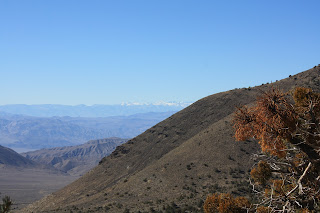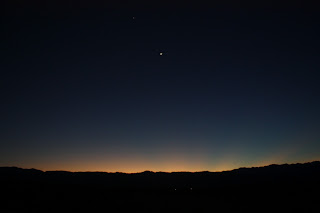After a brief stop at the visitor’s center at Furnace Creek so that we could pay for our days in the park — amazing that one of us should be old enough to qualify for the lifetime senior rate – we arrived at Golden Canyon shortly after 9 AM for a morning’s walk. Again, the canyon walls were relatively close near the entrance, then they opened up as we walked further in.
Many of the walls were filled with tiny crystals, broken off near tourist level, but visible just above the level where most tourists could reach up to touch them (photo below).
We hiked beyond Golden Canyon, past the Red Cathedral overhead,

having in mind to hike up to Zabriskie Point for what promised to be stunning views. As we got higher, we could look back over Golden Canyon and across Death Valley to the Telescope Peak / Wildrose Peak area where we had been hiking the previous day.
But again, my lack of exercise for the past month caught up to me, and the going was slow. We stopped at the Manly Beacon, where we traded photos with another hiking couple. Nancy assumed that its name was an oblique reference to its shape, but in fact we learned later that it is named for an historic figure who helped lead some Forty Niners away from certain death in the valley.
Time was growing short for us to get back to the family birthday party that was our reason for coming west, but we wanted to see the Artists Drive, a one-way drive where the rocks were brilliantly multi-colored.
So we headed back down to the parking lot, where we looked across the valley to the Wildrose Peak area in the Panamint Range:
On Artist Drive, we saw black/browns and whites as we drove in from the main road,
then reds, greens and blues as we got further in; there was a large basin of mostly dry lake bed visible in the distance.

As we walked back to the car, we could see Telescope and Wildrose Peaks across Death Valley
Another mile up the road was Artists Palette, a particularly intense area of multi hued rocks
As we drove along, I was especially impressed by the greens and blues among the rocks
Finally, we got back to the road, and headed toward the south end of the valley, then out to the main highways. We vowed not to stop, because it we were already going to be late for the family gathering. But we had no choice but to slow to a crawl, because as we passed the Coyote Spring, we were approached by a pair of beggars; we did not intend to feed them, but we also didn’t want to run them over.
Thus ended our Death Valley vacation, as we drove across the Black Mountains and the Greenwater Range -- more pretty countryside -- into Shoshone, then down to Baker and back to LA on I-15. The time was too short, but it was worth the trip.















































